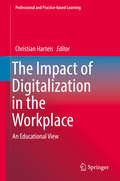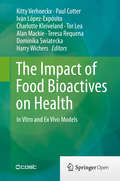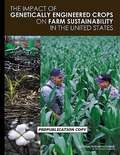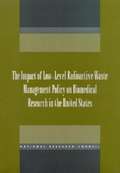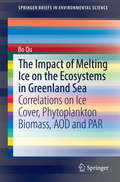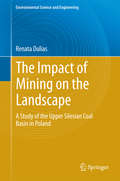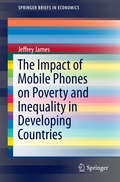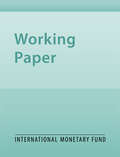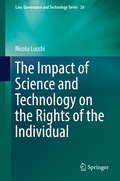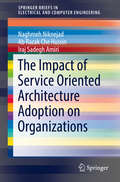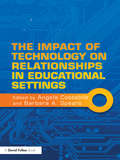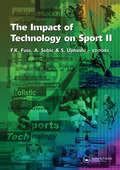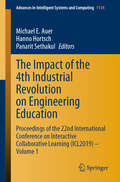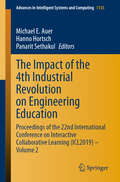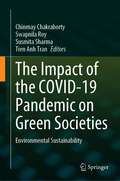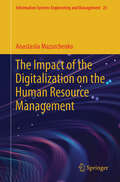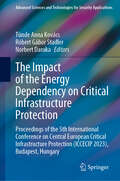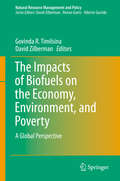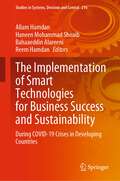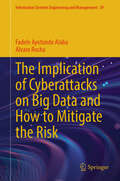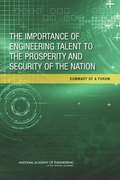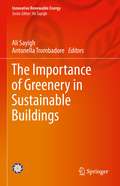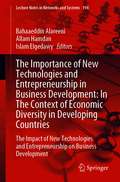- Table View
- List View
The Impact of Digitalization in the Workplace: An Educational View (Professional and Practice-based Learning #21)
by Christian HarteisThis edited volume brings together researchers from various disciplines (i.e. education, psychology, sociology, economy, information technology, engineering) discussing elementary changes at workplaces occurring through digitalization, and reflecting on educational challenges for individuals, organizations, and society. The latest developments in information and communication technology seem to open new potential, and the crucial question arises which kind of work can be replaced by technology? The contributors to this volume are scholars who have been conducting research on the influence of technological change on work and individuals for a long time. The book addresses researchers as well as practitioners in the field of adult education and human resource development.
The Impact of Food Bioactives on Health
by Kitty Verhoeckx Paul Cotter Iván López-Expósito Charlotte Kleiveland Tor Lea Alan Mackie Teresa Requena Dominika Swiatecka Harry Wichers"Infogest" (Improving Health Properties of Food by Sharing our Knowledge on the Digestive Process) is an EU COST action/network in the domain of Food and Agriculture that will last for 4 years from April 4, 2011. Infogest aims at building an open international network of institutes undertaking multidisciplinary basic research on food digestion gathering scientists from different origins (food scientists, gut physiologists, nutritionists. . . ). The network gathers 70 partners from academia, corresponding to a total of 29 countries. The three main scientific goals are: Identify the beneficial food components released in the gut during digestion; Support the effect of beneficial food components on human health; Promote harmonization of currently used digestion models Infogest meetings highlighted the need for a publication that would provide researchers with an insight into the advantages and disadvantages associated with the use of respective in vitro and ex vivo assays to evaluate the effects of foods and food bioactives on health. Such assays are particularly important in situations where a large number of foods/bioactives need to be screened rapidly and in a cost effective manner in order to ultimately identify lead foods/bioactives that can be the subject of in vivo assays. The book is an asset to researchers wishing to study the health benefits of their foods and food bioactives of interest and highlights which in vitro/ex vivo assays are of greatest relevance to their goals, what sort of outputs/data can be generated and, as noted above, highlight the strengths and weaknesses of the various assays. It is also an important resource for undergraduate students in the 'food and health' arena.
The Impact of Genetically Engineered Crops on Farm Sustainability in the United States
by National Research Council of the National AcademiesSince genetically engineered (GE) crops were introduced in 1996, their use in the United States has grown rapidly, accounting for 80-90 percent of soybean, corn, and cotton acreage in 2009. To date, crops with traits that provide resistance to some herbicides and to specific insect pests have benefited adopting farmers by reducing crop losses to insect damage, by increasing flexibility in time management, and by facilitating the use of more environmentally friendly pesticides and tillage practices. However, excessive reliance on a single technology combined with a lack of diverse farming practices could undermine the economic and environmental gains from these GE crops. Other challenges could hinder the application of the technology to a broader spectrum of crops and uses. Several reports from the National Research Council have addressed the effects of GE crops on the environment and on human health. However, The Impact of Genetically Engineered Crops on Farm Sustainability in the United States is the first comprehensive assessment of the environmental, economic, and social impacts of the GE-crop revolution on U.S. farms. It addresses how GE crops have affected U.S. farmers, both adopters and nonadopters of the technology, their incomes, agronomic practices, production decisions, environmental resources, and personal well-being. The book offers several new findings and four recommendations that could be useful to farmers, industry, science organizations, policy makers, and others in government agencies.
The Impact of Low-Level Radioactive Waste Management Policy on Biomedical Research in the United States
by Committee on the Impact of Low-Level Radioactive Waste Management Policy on Biomedical Research in the United StatesThe National Academies Press (NAP)--publisher for the National Academies--publishes more than 200 books a year offering the most authoritative views, definitive information, and groundbreaking recommendations on a wide range of topics in science, engineering, and health. Our books are unique in that they are authored by the nation's leading experts in every scientific field.
The Impact of Melting Ice on the Ecosystems in Greenland Sea
by Bo QuArctic marine ecosystems are largely impacted by changes associated with global warming. The sea ice in Greenland Sea plays an important role in regional and global climate system. The book investigate the relationships between phytoplankton biomass, measured using remotely sensed chlorophyll-a (CHL), aerosol optical depth (AOD) and sea-ice cover (ICE) in the Greenland Sea (20°W-10°E, 65-85°N) over the period 2003-2012. First hand Satellite data was used to do correlation analysis. Enhanced statistics methods, such as lag regression method and cointegration analysis method are used for correlation and regression analysis between 2 variables (up to 3 variables). ARMA model was used to prediction time series in the future 3 years. The book not only gives outline of ecosystem in Greenland Sea, how the ice impact to the local ecosystems, but also provides valuable statistical methods on analysis correlations and predicting the future ecosystems.
The Impact of Mining on the Landscape
by Renata DuliasThis book investigates the Upper Silesian Coal Basin (USCB), one of the oldest and largest mining areas not only in Poland but also in Europe. Using uniform research methods for the whole study area, it also provides a summary of the landscape transformations. Intensive extraction of hard coal, zinc and lead ores, stowing sands and rock resources have caused such extensive transformations of landscape that it can be considered a model anthropogenic relief. The book has three main focuses: 1) Identifying anthropogenic forms of relief related to mining activity and presenting them from a spatial, genetic and age perspective; 2) Determining the changes in the morphometric characteristics of relief and the conditions for matter circulation in open systems (drainage basins) and closed systems (land-locked basins) caused by the extraction of mineral resources; and 3) Estimating the extent of anthropogenic denudation using two different methods based on raw-material output and morphometric analysis. In Poland, no other mining area has undergone such intensive mining activity as the Upper Silesian Coal Basin during the last half century. Its share in the total extraction of mineral resources was as high as 32%. The total extraction of hard coal in the Upper Silesian Coal Basin from the mid-18th century until 2009 was the sixth largest in the world, and the permanent, regional effects of mining anthropopressure on the relief are among the most severe in the world. The anthropogenic denudation rate in the Upper Silesian Coal Basin, as well as the Ruhr Coal Basin (Ruhr District) and the Ostrava-Karvina Coal Basin, ranges from several dozen up to several hundred times higher than the rate of natural denudation, irrespective of the calculation method used. It would take the natural denudation processes tens of thousands of years to remove the same amount of material from the substratum as that removed through human mining activity.
The Impact of Mobile Phones on Poverty and Inequality in Developing Countries
by Jeffrey JamesThis book investigates at both the micro- and macroeconomic levels the impact of mobile phones on poverty and inequality in developing countries. To gauge the effects of mobile phones on these aspects, the author refers to the standard concept of technology adoption and also analyses the actual utilization of mobile phones as a means of communication and the degree to which they have supplanted fixed-line phones. Readers will learn why the substitution effect is stronger among poor than rich users and why the benefits of some mobile phone projects are confined to the local or village level, while in other projects the gains can be felt throughout the economy as a whole.
The Impact of Oil-Related Income on the Equilibrium Real Exchange Rate in Syria
by Jemma Dridi Maher HasanA report from the International Monetary Fund.
The Impact of Science and Technology on the Rights of the Individual
by Nicola LucchiThevolume is devoted to the relevant problems in the legal sphere, created andgenerated by recent advances in science and technology. In particular, itinvestigates a series of cutting-edge contemporary and controversialcase-studies wherescientific and technological issues intersect withindividual legal rights. The book addresses challenging topics at theintersection of communication technologies and biotech innovations such asfreedom of expression, right to health, knowledge production, Internet contentregulation, accessibility and freedom of scientific research.
The Impact of Service Oriented Architecture Adoption on Organizations (SpringerBriefs in Electrical and Computer Engineering)
by Iraj Sadegh Amiri Naghmeh Niknejad Ab Razak HussinThis book describes Service-Oriented Architecture (SOA) and the significant factors which affect its adoption, such as governance, strategy, complexity, Return on Investment (ROI), business and IT alignment, culture and communication, costs, and security. The study on which this book is based, involved a quantitative analysis to investigate the influential factors for adopting SOA, paving the way to further research in the field.
The Impact of Technology on Relationships in Educational Settings
by Barbara A. Spears Angela CostabileAs the linguistic, cognitive and social elements of our lives are transformed by new and emerging technologies, educational settings are also challenged to respond to the issues that have arisen as a consequence. This book focuses on that challenge: using psychological theory as a lens to highlight the positive uses of new technologies in relationships and educational settings, and to advocate technological learning opportunities and social support where the misuse and abuse of ICT occurs. The Impact of Technology on Relationships in Educational Settings sets out to explore the role of ICTs in relationship forming, social networking and social relationships within our schools and has grown out of the European Cooperation in Science and Technology (COST); Action on cyberbullying, involving 28 participating countries, and two non-COST countries, of which Australia is one. This cutting edge international text offers cross-cultural, psychological perspectives on the positive uses of new and emerging technologies to improve social relationships and examples of best practice to prevent virtual bullying. This comes at a time when much of the focus in current writings has been on the more negative aspects which have emerged as new technologies evolved: cyberbullying, cyber-aggression and cybersafety concerns. This text is ideally suited to researchers and practiitioners in the fields of Educational and developmental psychology, as well as those specialising in educational technology and the sociology of education.
The Impact of Technology on Sport II
by F. K. Fuss A. Subic S. UjihashiSport technology has to be seen from the holistic, as well as inter- and transdisciplinary point of view. Product development requires close collaboration between engineers, athletes, sports scientists, and business managers. It requires an in-depth understanding of engineering disciplines, life and sport sciences, as well as economics. The Impact
The Impact of the 4th Industrial Revolution on Engineering Education: Proceedings of the 22nd International Conference on Interactive Collaborative Learning (ICL2019) – Volume 1 (Advances in Intelligent Systems and Computing #1134)
by Michael E. Auer Hanno Hortsch Panarit SethakulThis book gathers papers presented at the 22nd International Conference on Interactive Collaborative Learning (ICL2019), which was held in Bangkok, Thailand, from 25 to 27 September 2019. Covering various fields of interactive and collaborative learning, new learning models and applications, research in engineering pedagogy and project-based learning, the contributions focus on innovative ways in which higher education can respond to the real-world challenges related to the current transformation in the development of education. Since it was established, in 1998, the ICL conference has been devoted to new approaches in learning with a focus on collaborative learning. Today, it is a forum for sharing trends and research findings as well as presenting practical experiences in learning and engineering pedagogy. The book appeals to policymakers, academics, educators, researchers in pedagogy and learning theory, school teachers, and other professionals in the learning industry, and further and continuing education.
The Impact of the 4th Industrial Revolution on Engineering Education: Proceedings of the 22nd International Conference on Interactive Collaborative Learning (ICL2019) – Volume 2 (Advances in Intelligent Systems and Computing #1135)
by Michael E. Auer Hanno Hortsch Panarit SethakulThis book gathers papers presented at the 22nd International Conference on Interactive Collaborative Learning (ICL2019), which was held in Bangkok, Thailand, from 25 to 27 September 2019. Covering various fields of e-learning and distance learning, course and curriculum development, knowledge management and learning, real-world learning experiences, evaluation and outcomes assessment, computer-aided language learning, vocational education development and technical teacher training, the contributions focus on innovative ways in which higher education can respond to the real-world challenges related to the current transformation in the development of education. Since it was established, in 1998, the ICL conference has been devoted to new approaches in learning with a focus on collaborative learning. Today, it is a forum for sharing trends and research findings as well as presenting practical experiences in learning and engineering pedagogy. The book appeals to policymakers, academics, educators, researchers in pedagogy and learning theory, school teachers, and other professionals in the learning industry, and further and continuing education.
The Impact of the COVID-19 Pandemic on Green Societies: Environmental Sustainability
by Chinmay Chakraborty Swapnila Roy Susmita Sharma Tien Anh TranThis book covers the sustainability issues of a green environment towards economics and society in terms of alteration in industrial pollution levels, effect of reduced carbon emissions, changes in water bodies characteristics with respect to heavy metal contamination, monitoring of associated impact with respect to ecology and biodiversity, impact of reduced noise levels and air quality influences on human health, handling and management of biomedical waste. According to WHO, 80% of people living in urban areas are exposed to air exceeding safe limits. The advent of "sustainability‟ in development science has led planners to apply evolving notions of "sustainability‟ to the contemporary debate over how cities and regions should be revitalized, redeveloped, and reformed. Market allocation of resources, sustained levels of growth and consumption, an assumption that natural resources are unlimited and a belief that economic growth will „trickle down‟ to the poor have been its hallmarks. The recent advance technology helps to promote green and clean modern societies continuously. The Internet of things will be playing an important role in the upcoming years in environment protection and sustainable development. There is a focus on paradigm shift in the sustainable development for the green environment during the period of isolation of COVID-19. This is the moment for the mobilization against the climate crisis. The sudden fall in pollutants and subsequent blue skies signifies a dramatic shift for India and also other affected countries during this period. Fighting climate change requires a collaborative approach between all spheres of society unlike the former. It must heavily redirect resources towards local, sustainable activities, including education, health, sustainable agriculture and circular management of resources. The impact of COVID-19 pandemic which has resulted in the dramatic change in the different aspects of the environment. The global lockdown has led to a rejuvenation of nature, ecosystems, biodiversity. Even urban environments are discovering a degree of peace and serenity, which led to decrease in greenhouse gas emission.
The Impact of the Digitalization on the Human Resource Management (Information Systems Engineering and Management #25)
by Anastasiia MazurchenkoThis book is strongly recommended for L&D professionals, HR managers, senior managers, and company owners who want to adapt their employees' training and skills development to the changing requirements of digitalization and technological progress, considering the specifics of the sector in which their organizations operate. It is unique in that it compares the views of employers and employees on digitalization and the development of digital competencies and skills and highlights the need to align them as part of implementing a long-term HR development strategy in an organization. The book features statistical hypothesis testing and links to the case studies, and it covers such areas as the historical development of digitalization, advantages, and disadvantages of technologies in HR management, the role of competency models, and organizational training in conditions of the Fourth and Fifths Industrial revolutions. The book also explores how employees' digital skill levels depend on age and career longevity and how much the level of digital readiness of organizations is affected by labor market trends and the impact of the COVID-19 pandemic. Taking into account practical recommendations and issues to consider, it emphasizes the need to update competency models, support a culture of continuous organizational training and knowledge sharing, and extend an organization's digital infrastructure to retain competitive human resources in the dynamic digital age. Readers will receive a comprehensive understanding of digitalization in human resource management and how it influences competency requirements for employees in different sectors in the international context.
The Impact of the Energy Dependency on Critical Infrastructure Protection: Proceedings of the 5th International Conference on Central European Critical Infrastructure Protection (ICCECIP 2023), Budapest, Hungary (Advanced Sciences and Technologies for Security Applications)
by Tünde Anna Kovács Norbert Daruka Róbert Gábor StadlerThis book presents cutting-edge research on the impact of energy dependence and strategies to mitigate it. As a crucial component of critical infrastructure, energy security is a top priority for nations worldwide. The protection of this infrastructure, along with the latest research tools and methodologies, is of significant interest to both policymakers and industry leaders. The book delves into two primary areas of research: cybersecurity and physical security, summarizing the latest findings in these critical fields. The papers in this volume offer valuable insights for both academic and industrial audiences, addressing the pressing challenges of energy security. Energy is integral to every aspect of our daily lives. Our comfort, as well as our safety, hinges on the uninterrupted supply of energy. Recent global events, particularly the Russian-Ukrainian war, have underscored the vulnerability of nations lacking sufficient energy resources. Europe's energy supply has been severely disrupted by sanctions, highlighting the need for energy resilience. However, this crisis has also accelerated the adoption of renewable energy sources, marking a pivotal shift towards sustainable energy solutions.
The Impacts of Biofuels on the Economy, Environment, and Poverty
by David Zilberman Govinda R. TimilsinaInterest in biofuels began with oil shocks in the 1970's, but the more rapid development and consumption of biofuel industry in recent years has been primarily driven by mandates, subsidies, climate change concerns, emissions targets and energy security. From 2004 to 2006, fuel ethanol grew by 26% and biodiesel grew by 172%. As biofuel production continues to expand, investments in capacity expansion and research and development have been made. The 2008 food crisis emphasized the need to re-examine biofuel consequences. Biofuels remain an important renewable energy resource to substitute for fossil fuels, particularly in the transportation sector, yet biofuels' success is still uncertain. The future of biofuels in the energy supply mix relies on mitigating potential and improving the environmental gains. This book brings together leading authorities on biofuel from the World Bank to examine all of the impacts of biofuel (economic, social, environmental) within a unified framework and in a global perspective, making it of interest to academics in agricultural and environmental economics as well as industry and policy-makers.
The Imperfect Environmentalist
by Sara GilbertActress, producer, mother, and imperfect environmentalist, Sara Gilbert understands how helping the environment can seem overwhelming. Between keeping up with work, friends, and kids, who has the time or money to maintain a compost pile, become an activist, or knit a sweater out of recycled grocery bags? Fortunately, we now know that small changes here and there in our everyday lives can make a big impact on the environment. We just need to know where to begin. That's where Gilbert comes in, with this tongue-in-cheek reference guide packed full of helpful information, available at your fingertips. Read it cover to cover or just open it up to a random page; you can take what you want from it when you want. Whether you've got money to burn or have to crash on a friend's couch, here are all of the eco-essentials to get the planet back on track, and you won't have to hug a single tree--unless tree-hugging is your thing. Sharing the basics on health and beauty, work and money, home and gardening, family and fitness, and more, The Imperfect Environmentalist cuts through the clutter--both in our homes and in our heads--and offers simple approaches to help us clear out the pollutants, put down the poisons, and begin to breathe easy again--one 100% recycled page at a time.Advance praise for The Imperfect Environmentalist "This book really opened my eyes. Then my eyes started stinging and tearing from all the toxins in the environment I'm now aware of. Thanks, Sara, I have a lot to do now."--Lisa Kudrow "Sara's passion and commitment to the environment have given me an awareness that I never had before about our planet. I learn from Sara every day and she makes me want to be a better person. See, you can teach an old dog new tricks."--Sharon OsbourneFrom the Trade Paperback edition.
The Implementation of Smart Technologies for Business Success and Sustainability: During COVID-19 Crises in Developing Countries (Studies in Systems, Decision and Control #216)
by Allam Hamdan Bahaaeddin Alareeni Haneen Mohammad Shoaib Reem HamdanIndustry 4.0 technologies identified as the main contributor to the digitalization era. New technology delivers optimal outputs by utilization of effective resource. Therefore, smart technologies that has inventive and creative objects became critical to enterprise; recent studies shows that its led enterprises business such as SMEs to considerable investments, which many organizations over the world attempt to use innovative technologies such as IoT and AI, these technologies have potential on sustainable business models. In addition to that, innovation usage in business models led to significant benefits towards sustainability concept in SMEs marketplace. Furthermore, Sustainability objectives refers to corporate sustainability term, which integrate enterprise operations with social, educational, environmental and economic benefits, as process of decision-making can impact during sustainability implications. This book focus on the implementation of smart technologies for growing business, the book includes research articles and expository papers on the applications of technology on Decision Making, Healthcare, Smart Universities, Advertising, E-marketing, Public Sector and Digital Government, FinTech, RegTech. Some researchers also discussed the role of smart technologies in the current COVID-19 pandemic, whether in the health sector, education, and others. On all of these, the researchers discussed the impact of smart technologies on decision-making in those vital sectors of the economy.
The Implication of Cyberattacks on Big Data and How to Mitigate the Risk (Information Systems Engineering and Management #39)
by Alvaro Rocha Fadele Ayotunde AlabaThis comprehensive book explores the challenges posed by cyberattacks on big data systems and their corresponding mitigation strategies. The book is organized into logical chapters, each focusing on specific aspects of the subject, ensuring clarity and depth in addressing the multifaceted nature of the problem. The introductory chapter provides a clear overview of the problem, introducing the prevalence of cyberattacks on big data systems, the motivation for addressing these risks, and the goals of the book. It also outlines the goals of the book, such as identifying vulnerabilities, evaluating mitigation strategies, and proposing integrated solutions. The second chapter provides a detailed examination of cyberattacks, emphasizing their implications for big data systems. It systematically categorizes tools and techniques available for mitigating these risks, including identity and access management (IAM), symmetric data encryption, network firewalls, IDPS, data loss prevention (DLP), SIEM, DDoS protection, and big data backup and recovery strategies. The book focuses on key mitigation techniques, such as IAM, encryption methods, network segmentation, firewalls, and intrusion detection systems. It also proposes an integrated cybersecurity model, combining these solutions for enhanced effectiveness against cyberattacks. The book also identifies research gaps and suggests areas for future research, such as adapting to emerging technologies and improving scalability in big data security frameworks. The book is a valuable resource for cybersecurity professionals, researchers, and practitioners aiming to address the unique challenges posed by cyberattacks on big data systems. The book aims to equip various professionals with the knowledge and strategies necessary to address the vulnerabilities associated with cyberattacks on big data environments.
The Importance of Engineering Talent to the Prosperity and Security of the Nation
by Steve OlsonThe quality of engineering in the United States will only be as good as the quality of the engineers doing it. The recruitment and retention of talented young people into engineering therefore need to be top national priorities, given the crucial importance of engineering to our prosperity, security, health, and well-being. Only 4. 4 percent of the undergraduate degrees awarded by US colleges and universities are in engineering, compared with 13 percent in key European countries (the United Kingdom, Sweden, Finland, Denmark, Germany, and France) and 23 percent in key Asian countries (India, Japan, China, Taiwan, South Korea, and Singapore). In the past, the United States has been able to attract engineering graduate students and professionals from other countries to meet the need for engineering talent in the public and private sectors. But other countries are providing increasingly attractive opportunities for engineers, with excellent salaries, facilities, and economic growth potential. The United States can no longer assume that the best engineering talent in the world will want to come to this country. "The Importance of Engineering Talent to the Prosperity and Security of the Nation" is the summary of a forum held during the National Academy of Engineering's 2013 Annual Meeting. Speakers discussed the opportunities and challenges of creation and wise use of engineering talent, and made recommendations for recruitment and retention strategies. This report assesses the status of engineering education in the U. S. and makes recommendations to promote and improve engineering education.
The Importance of Greenery in Sustainable Buildings (Innovative Renewable Energy)
by Ali Sayigh Antonella TrombadoreThis book covers the important aspects of greenery in buildings, both in the landscape and within buildings, examining how greenery improves comfort and appeal in sustainable buildings. The book is part of the World Renewable Energy Network’s drive to encourage architects and builders to use greenery as much as possible in their design to reduce energy consumption and provide a pleasant appearance and pleasing aspect to their buildings. It shows and demonstrates how widespread the use of greenery is in buildings, and the books 17 chapters were chosen from 12 different countries representing a truly global look at the use and benefit of using greenery in buildings. This book is aimed at architects, building construction authorities, urban planners, and policymakers to encourage the use of greenery in their future buildings and explain why it is important to do so.
The Importance of New Technologies and Entrepreneurship in Business Development: The Impact of New Technologies and Entrepreneurship on Business Development (Lecture Notes in Networks and Systems #194)
by Islam Elgedawy Allam Hamdan Bahaaeddin AlareeniThis book introduces the students, researchers and practitioners into the subject and enabling technologies and applications pertaining to of technology, entrepreneurship and business development through research articles, case studies etc. It is primarily intended for academic purposes for learners of computer Science, management, accounting and information systems disciplines, economics,- entrepreneurship. Publishing chapters in the book is new innovative idea to spread the book in the Middle East and Arab countries and make the book achieve more sales. As many students in all levels, graduates and undergraduates in addition to research, professionals are not able to get sufficient resources because of the language concern.
The Importance of Packaging Design for the Chemistry of Food Products
by Salvatore Parisi Giovanni Brunazzi Amina PerenoThis Brief defines reliable correlations between the food packaging design and its chemical features in terms of an 'integrated food product' (the synergistic union composed of the edible content and its container). A good design, as described in this Brief, implies the best choices from a series of possibilities, taking into account economical and commercial influences or limitations in the production and processing chain and the chemical interactions that can arise between the food containers and the contained edible material. This Brief highlights how the different requirements can be combined, while avoiding dangerous food risks originating from the chemical interaction between the container and the product. Different designs are critically analysed with relation to the effect on contained foods. The influences and resulting consequences of different possible food packaging designs are highlighted and discussed in selected case studies for some every-day products (like potato chips).
